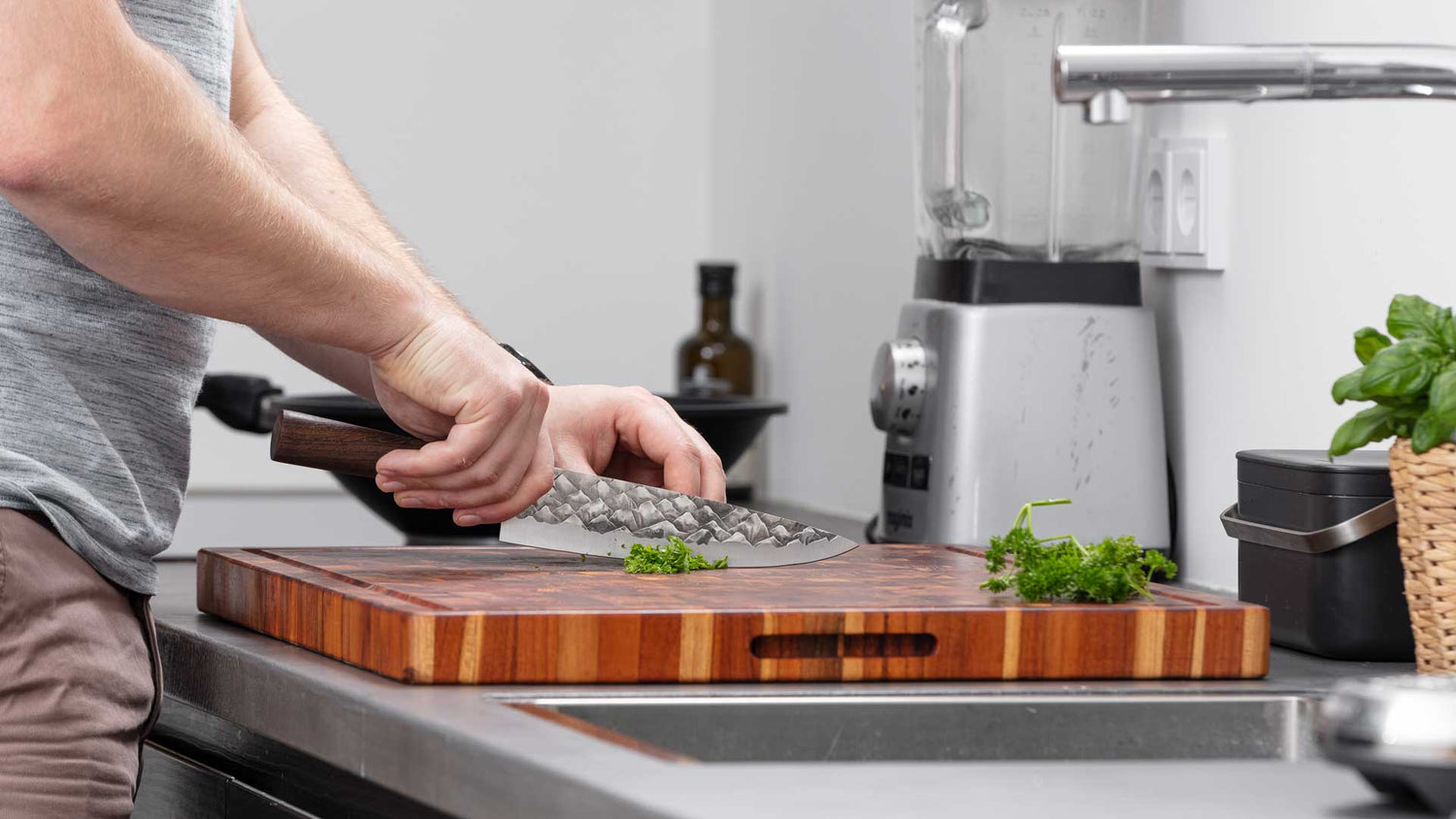In this article we'll look at the differentiating factors between Chef’s knives, let's call it knife anatomy 101. This should help you in choosing the right knife for you. We’ll also explain which choices went into designing our BARE Cookware 8” Chef’s knife.
1. BLADE PROFILE
The first thing that separates knives is their shape. The blade profile of a (Chef’s) knife can be rounder or flatter. A rounder blade profile is referred to as having more belly. Works for Chef’s too. A knife with a more pronounced belly is better suited for rocking. A flatter blade edge is better geared towards straight up and down chopping. We have a complete overview of knife types here.
The width of the blade profile is a design choice too. A wider blade offers a wider base for the fingers to rest against. On the downside: a wider blade is heavier, resulting in less speed during fast work.
Lastly a knife blade can be profile tapered, meaning that it gradually gets thinner from spine to cutting edge. This is seldomly used, as the primary bevel accomplishes most of the benefits gained by this difficult to produce geometry design. More on that further down.
2. SPINE PROFILES
Obviously, the thickness of the spine is a defining factor in knife design. A thicker blade is stronger, but heavier. A thicker spine is also more comfortable when pushing down on the spine of the knife. For our BARE Chef’s knife, we have settled on a straight spine thickness of 2.5mm. This allows the knife to withstand all daily cutting tasks without becoming cumbersome.
Besides thickness, the spine of a knife can be shaped to. There are two varieties of knife spine types:
- The straight spine. Straightforward and functional. The straight spine does not vary in thickness. It offers the most strength and durability.
- The tapered spine. Here the spine gets thinner from handle to tip. If a blade gradually thins toward the tip this is called a full distal taper. This is especially useful in knives for delicate or fast work. A full distal taper adds significant cost in manufacturing. A drawback of a full distal taper is the decreased strength of the blade near the tip. This means increasing the risk of breaking the tip of your knife should you drop it.
3. THE BOLSTER
The bolster is the part that merges the handle into the knife. Structurally, a bolster is not necessary. It can be a very beneficial part to improve the balance of a knife. Some knives come with a full bolster that extends to the heel of the knife. This adds a strong point at the heel of the knife that can then be used to hack through small bones. We’re no fans of the full bolster as it makes sharpening almost impossible.
BARE Knives come with a half-bolster that balances the knife out and increases ergonomics when pinch-gripping the blade. The half-bolster ensure you can easily sharpen your knife yourself. Read more about knife sharpening here.
4. THE TANG
The tang is the part of the blade steel that extends into the handle. There are two types of tangs.
- The full tang. Extends fully into the handle. A full tang does not always have to be visible, but almost always is. A full tang provides more weight in the handle and is stronger than a partial tang. It should be noted that this added strength is only beneficial in survival or hunting knives. Kitchen knives should never be strained to the point where such added strength would make a difference.
- Partial tang. Extends partially into the handle. Japanese knives are traditionally made with a partial tang and no bolster. For kitchen work this construction is plenty strong enough. In the kitchen it is a question of aesthetics and weight balance whether you prefer a partial or full tang.
5. THE HANDLE
Where the rubber meets the road. A handle should feel right. This is very subjective. We encourage you to try different types before you buy a knife. A handle should provide good grip, also in wet or oily conditions.
Besides ergonomic, a handle must last. That is why BARE Cookware knives come with a natural hardwood handle. These handles last a lifetime when taken care of. See our hardwood maintenance guide for more info.
LOOKS

Lastly, there’s look. Though we are very utilitarian here at BARE, we love a knife that just looks good. Additionally: a beautiful product is more sustainable and durable. Because you will care better for a beautiful knife. Beautiful tools do not get thrown out so fast. That is why we have designed our knives to look as they do. We want to make a lasting impression.
In future articles we will dive deeper into edge geometry and grind types. Stay tuned!







Leave a comment
All comments are moderated before being published.
This site is protected by hCaptcha and the hCaptcha Privacy Policy and Terms of Service apply.